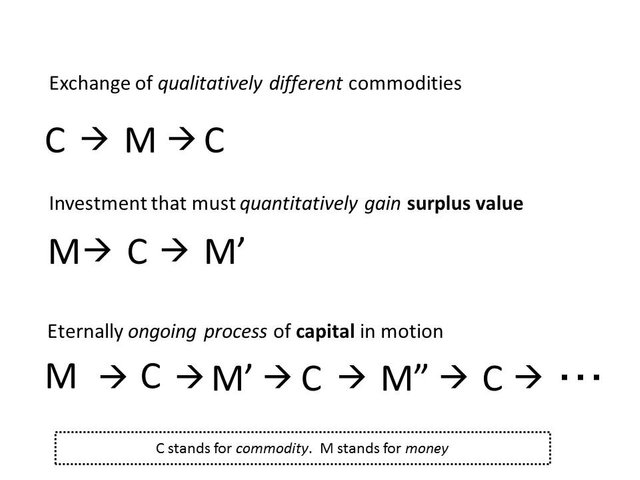The Pervert’s Guide to M-C-M':
 link
link
The Pervert’s (ha-ha Zizekian verbiage) guide to M-C-M':
(Warning: this post will abruptly move on from one point to the next point as to merely introduce Marxist Economic terms that you may have heard from Marxists on the net, reading carefully is advised.)
- M is Money (Capital)
- Investment of machines and resources (Constant Capital, c).
- Buying up labor power (Variable Capital, v and sometimes symbolized as wages as labor-cost).
- Basically, anything from M'.
- C is Commodity
- Zero Sum Exchange (I lose what I gain, or I gain what I lose) in the market place.
- Use-value of C for the Bourgeoisie is only for selling. The capitalist no more cares of the commodity other than the money they got.
- Use-value of C for the buyer is only to buy until the exchange is made and then the buyer sees the commodity as what they desired.
- Use-value of C for the middle-man is to sell once bought to other vendors.
- But the use-value isn't entirely/equally transferred from people to people when looking at the Middle-Man (that's because each particular use-value isn't a universal one*).
- M' (New Money/Capital)
- Composed of: M + Surplus Value (s) + super-profit.
- SNLT (Socially Necessary Labor Time): The Socially Necessary time it takes for a commodity to be produced.
- Individual SNLT > Market SNLT -> Deficit and the death of company.
- Individual SNLT < Market SNLT -> Super-profits, expansion and living to see another day.
- Surplus Value (s) -> The excess of value produced by the labor power of a proletariat over the amount the wages they are paid in a given day.
- Most of it going back to the Capitalist, useful for profit generated as to buy up more resources and expand operations (id est increasing constant capital in order to make more commodities).
- Super-profits -> Produce more than competition and still sell at the same price.
- Equalization of Profits -> Period when the profits equalize at the event of super-profits.
- Exchange-Value =/= price
- They co-determine each other but never equal each other.
- Use-Value =/= price
- This is an error of STV (Subjective Theory of Value):
- My view of a pencil can be astronomical or high up on my list, but yours the complete opposite.
- Are either of us correct? Is the middle road option correct? Are either of us dead wrong?
- The answer is no for all three.
- Use-Value is useful for Supply and Demand of a product:
- It helps allocate labor in an industry.
- Tells the bourgeoisie if the commodity needs to increase/decrease production.
- Tells the bourgeoisie if ventures are worth investing into.
- This is an error of STV (Subjective Theory of Value):
- Socially Necessary Labor -> Intrinsic Value.
- Scarcity/Utility -/-> Intrinsic Value.
- Scarcity: The lack of commodities come about due to the fact that there isn't enough labor put into something or is artificially created by hoarding of commodities away from the market place.
- Diamonds have an minuscule SNLT to produce one commodity of them for an average amount of labor, yet rarely do we see any in ever "Diamond/Jewelry" stores. Thus, it gets a high price but the Intrinsic Value of the item really hasn't increased, nor would it decrease if all the Diamonds were pumped in the marketplace.
- Utility: Much like the conflation of "Use-Value = price," this STV analysis point fails to comprehend contradictory personal opinions of the Public within the same area and the fact that market prices reflect not the will of the people.
- Scarcity: The lack of commodities come about due to the fact that there isn't enough labor put into something or is artificially created by hoarding of commodities away from the market place.
Footnotes
Footnote 1: Going a little Hegelian here, we can't conflate a particular to be liken to that of a Universal since particulars are Universals In-Itself and things apart of them, For-Itself they aren't Universals to other particulars like them.
- To take the example of an apple:
- The Apple is a Universal for apples, but a particular to all Fruits;
- The particulars of the Apple can be generalized to the Red Apples, Yellow Apples, Green Apples and so on and so on.
- Let's look at the Red Apples:
- The general Red Apples are particulars to the Red Apple and distinct to each other based on contingencies.
- These contingencies, related to the Red Apple in this case, can be based on, and are codependent of each other like location, history, labor from agriculture and harvesting and the weather that all factor into a particular Red Apple.
- And this Red Apple belongs to its own Universal, that being of the farm's own Red Apples.
- Which the farm's own Red Apples are particular to the Other and part of the Universality of a region which that is part of the state/province which that is a part of a country and so on and so on.
- The chain of Particular-Universal can be symbolized as such:
- Universal (God, Absolute, Reason, Other, ...) <-> first particular (a universal to the second particulars, but a particular to the absolute) <-> ... <-> nth particular (the most individualized we can get of the original Universal and a particular to other nth particulars).
Congratulations @theironfelix! You have completed some achievement on Steemit and have been rewarded with new badge(s) :
Click on any badge to view your own Board of Honor on SteemitBoard.
For more information about SteemitBoard, click here
If you no longer want to receive notifications, reply to this comment with the word
STOPDo not miss the last announcement from @steemitboard!
Hope your picture is very good and better,thanks.......
Wonderful post ..thanks for sharing...Best of luck friend ✫ resteemid
follow me
communism or Mad Max collapse